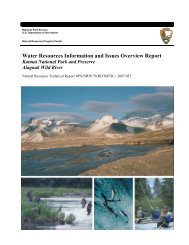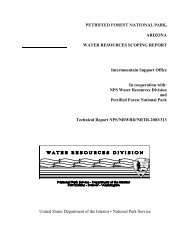ENVIRONMENTAL CONTAMINANTS ENCYCLOPEDIA ...
ENVIRONMENTAL CONTAMINANTS ENCYCLOPEDIA ...
ENVIRONMENTAL CONTAMINANTS ENCYCLOPEDIA ...
You also want an ePaper? Increase the reach of your titles
YUMPU automatically turns print PDFs into web optimized ePapers that Google loves.
effects in the marine environment [770,853].<br />
Alkyl naphthalenes are usually found in the same<br />
petroleum products as naphthalenes, often in higher<br />
concentration than the parent compound naphthalene<br />
[796]. Since alkyl PAHs are often more abundant in<br />
fresh petroleum products than their parent<br />
compounds, and the proportion of alkyl PAHs to<br />
parent compound PAHs increases as the oil ages, it<br />
is very important to analyze oil samples for alkyl<br />
PAHs any time that biological effects are a<br />
concern.<br />
In general, alkyl naphthalenes pose similar hazards<br />
or worse hazards than naphthalene [851]. Within an<br />
aromatic series, acute aquatic toxicity increases<br />
with increasing alkyl substitution on the aromatic<br />
nucleus [851]. Naphthalenes are no exception to<br />
this overall generalization for PAHs, as there is<br />
an increase in toxicity as alkylation of the<br />
naphthalene structure increases [853]. For<br />
example, the order of most toxic to least in a<br />
study using grass shrimp (Palaemonetes pugio) and<br />
brown shrimp (Penaeus aztecus) was<br />
dimethylnaphthalenes > methylnaphthalenes ><br />
naphthalenes [853]. There is also an increase in<br />
toxicity to marine planktonic algae as alkylation<br />
of the naphthalene structure increases [366, Jensen<br />
K et al; Limnol 15 (2): 581-4 (1984)].<br />
Although there is less toxicity information<br />
available for most of the alkyl PAHs than for their<br />
parent compounds, most alkyl PAHs appear to be at<br />
least as toxic or hazardous as the parent compound.<br />
As can be seen from the preceding paragraph, some<br />
have been documented to be more toxic.<br />
Total naphthalenes (total NPHs): Until more<br />
complete information on the effects of all the<br />
alkyl naphthalenes is available, risk assessment<br />
experts suggest adding all alkyl naphthalene<br />
concentrations plus the parent compound<br />
concentration and comparing the sum to known<br />
toxicological effects benchmarks and criteria for<br />
the respective parent compound (Bill Stubblefield,<br />
ENSR, personal communication, 1995). In this<br />
method, naphthalenes are the sum of C0-C4<br />
naphthalenes (total NPHs) [521]. In other words,<br />
the concentration of total naphthalenes is the sum<br />
of the following concentrations: total C1<br />
naphthalenes (including all methyl naphthalenes) +<br />
total C2 naphthalenes (including<br />
dimethylnaphthalenes) + total C3 naphthalenes<br />
(including trimethyl naphthalenes) + total C4

















